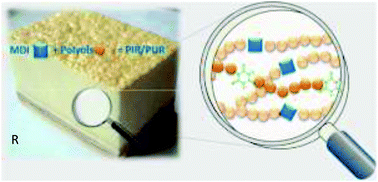Isocyanurate formation during rigid polyurethane foam assembly: a mechanistic study based on in situ IR and NMR spectroscopy†
Abstract
An in-depth exploratory study on the mechanism of isocyanurate formation during the assembly of rigid PU/PIR polyurethane foams was performed thereby unravelling the role and working principle of the catalyst. Mimicking the complex pattern of the foam with mono-functional equivalents, the pathways to isocyanurate formation were investigated. Reactions focusing on potassium acetate as benchmark catalyst were thereto followed by in situ IR and NMR spectroscopy. Two pathways to isocyanurate formation from isocyanates were revealed: a one-component route via cyclotrimerization and a two-component route via carbamate and allophanate. We show that in the presence of alcohol and along with the formation of carbamate, isocyanurate is formed preferentially according to the two-component route in three consecutive steps. Allophanate, which in this study was isolated and characterized, is formed in situ in small transient concentrations from carbamate and the excess of isocyanate. For the first time it is proven that the allophanate intermediate undergoes an addition–elimination step with nucleophilic species to provide the isocyanurate.



 Please wait while we load your content...
Please wait while we load your content...